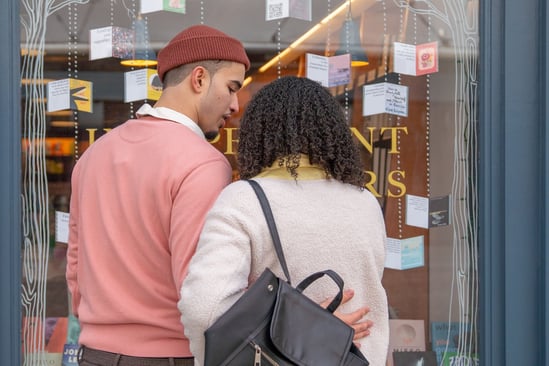How Holiday Shopping Patterns Have Changed: An 8-Vertical Breakdown

To successfully complete your ecommerce holiday planning and respond to trends in an effective manner, your brand must remain ready and agile — no matter what the market throws your way.
This means finishing the year and starting anew with effective processes to reach your customers with the right information about your products on whatever channel they’re shopping.
While ecommerce is booming overall, not every industry has experienced equal success, and trends vary across verticals.
Here’s a look at some of the most notable shopping changes across verticals to keep in mind as your brand finalizes this year’s plan and looks ahead to 2022.
Consumer Goods
Shoppers’ purchasing priorities shifted dramatically in 2020, and consumer goods brands felt the impact. There was the first drop in the personal consumption of goods and services since 2010, according to McKinsey. Consumption was down over 11% year-over-year.
However, in 2021, spending on goods and services bounced back, with spend on services expected to continue to increase in 2022, according to Deloitte.
Food and Beverage
Digital shopping options like buy online, pick up in store (BOPIS), same-day delivery, and curbside pick-up grew in 2020 overall and during the holiday shopping season.
Eighty-five percent of shoppers have increased their use of curbside pick-up since the pandemic started according to a study compiled by Incisiv. It’s likely that consumers will continue to use these services beyond 2021.
Home Improvement
In 2020, many people didn’t stop engaging in their favorite activities. They simply moved them to a more private, in-home environment. As such, sales increased for equipment related to in-home offices, gyms, and hangout spaces.
According to the Leading Indicator of Remodeling Activity (LIRA) released by the Remodeling Futures Program at the Joint Center for Housing Studies of Harvard University, year-over-year gains in annual improvement and repair spending are projected to reach 9% in the fourth quarter of 2021 and maintain that pace into 2022.
Furniture and Home Goods
Ecommerce web traffic for homeware spiked 318% in Q2 of 2020 in the U.K. and Ireland according to Salesforce. Some retailers, like Moda Operandi, saw a 97% increase in homeware items sold (per Forbes).
In 2021, furniture and bedding sales are forecasted to hit nearly $120 billion, a more significant 5% year-over-year growth according to findings from ROI Revolution.
Electronics
Working from home is projected to continue, resulting in continued demand for tech and electronics that make work-from-home environments possible.
Gaming is also still growing, and the industry is experiencing boosts in sales for equipment like VR headsets. The 2020 Evolution of Entertainment report shows video game engagement in the U.S. grew significantly in 2020, and the number of consumers playing video games in the U.S. increased to 79%.
Sports and Outdoor
Home improvement wasn’t the only vertical to see significant boosts in sales. Sporting goods saw an 85% order count growth year-over-year and page view growth on par at 84%, according to Bazaarvoice.
Retail tracking data from NPD shows outdoor equipment sales grew significantly in the second half of 2020. And in the first half of 2021, equipment sales at sports specialty retail grew by 23% compared to the same pre-pandemic period in 2019.
Fashion and Apparel
Traditional retail fashion sales numbers declined in 2020. However, direct-to-consumer (DTC) alternatives that focus on niche products and sustainability had a successful 2020.
According to research compiled by Blueprint, four of the top 10 fastest-growing brands in terms of website traffic were niche fashion and apparel brands: Cubcoats, For Days, Hari Mari, and Draper James.
Consumer demand for sustainable business practices is also garnering ongoing attention. Stats show that 52% of consumers want retailers to prioritize sustainability according to a survey by Nosto.
Personal Care and Beauty
The beauty vertical is up from $483 billion in 2020 to $511 billion in 2021, with an annual compounded growth rate of 4.75% worldwide, according to Common Thread Collective. There are no signs of this growth projection slowing down.
More consumers are buying on social channels than ever before, and consumers are willing to pay more for high-quality products.
Staying Ahead of Trends to Come
While ecommerce holiday planning may look different year after year, there is a solution that can provide your brand with a critical edge against the competition: digital transformation.
Digital transformation ensures that your brand has the correct people and processes in place to respond to any and every trend the market throws your way in 2022 and beyond.
For more insight on ecommerce holiday planning and the trends that defined 2021, download the full holiday trend report.
Written by: Ashley R. Cummings
Ashley R. Cummings (she/her) is a freelance writer specializing in ecommerce software as a service (SaaS). Her words appear across the web in places like Insider, LinkedIn, ShopifyPlus, and Hashtagpaid.
Recent Posts
How To Kick Shopping Cart Abandonment to the Curb
Gen Alpha Trends: How the Next Generation Influences Buying Behavior and Decisions
Do Brands Need Social Media Influencers In The Age of AI?
Subscribe to the Below the Fold Newsletter
Standing out on the digital shelf starts with access to the latest industry content. Subscribe to Below the Fold, our monthly content newsletter, and join other commerce leaders.


.svg)